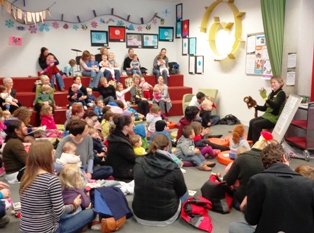Good news for dog-lovers and book-lovers alike — we’re bringing back our popular Read to Kurī programme at Ruth Gotlieb (Kilbirnie) Library throughout Term 1 this year!
Every Thursday after school from the 15th of February on, you’ll be able to book in a 15-minute slot to read to one of our gorgeous therapy pups from our friends at Canine Friends Pet Therapy. Read on to learn more about Read to Kurī, and how you can book your session!

Archie (right) is one of the lovely doggos joining us for this programme!
What is Read to Kurī?
At Read to Kurī, you will book in for a 15-minute one-on-one reading session with one of our gorgeous doggy pals from Canine Friends Pet Therapy. You will be able to choose a book and curl up somewhere cosy in the library to read with your chosen dog. The dog’s handler will be present at all times.
Read to Kurī aims to help tamariki improve their literacy, self-confidence, and self-esteem in a relaxed, non-judgemental environment. All dogs have been trained and tested for health, safety, and temperament, and many have experience working with young children.
Research shows that therapy dogs:
- Can increase a child’s relaxation while reading
- Listen attentively
- Do not laugh, judge or criticise a child’s reading level
- Allow children to proceed at their own pace
- Can be less intimidating to read to than a child’s peers
This programme is perfect for tamariki aged 5+ who would like to practice their reading skills while making a new canine friend at the library. Bookings are essential as spaces are limited — visit our Event Calendar to place your booking.
Meet the Kurī
We are very lucky to have two talented pooches join us for Read to Kurī at Kilbirnie Library during the term. Read on to find out a little bit more about each dog!
Kurī 1: Archie
 Handler: Penny Griffith
Handler: Penny Griffith
“My name is Archie and I am six years old. I absolutely love people, and especially children!
I am a Schnoodle — my mummy is a Schnauzer and my daddy is a Poodle.
I think I will be very good at listening to children reading me stories… maybe they can even teach me how to read!”
Penny and Archie will be at Kilbirnie Library from 3.30 – 4.30pm every second Thursday starting on Thursday 29 February.
Kurī 2: Mātai
“Kia ora! My name is Mātai (prounounced maa-tie) and I’m a 4 year old Golden Retriever.
I’m a very chilled out dog with a very warm and patient nature. I love people and especially children. They are super fun to hang out with.
I enjoy sitting or lying listening to stories, and when the time is right, playing. My favourite place is the beach. I have fun chasing sticks and balls, playing tug of war, and swimming (even when my mum has told me it’s not swimming time )
I think I’d like listening to you reading me a story.”
Lisa and Mātai will be at Kilbirnie Library from 3.30 – 4.30pm on Thursdays 15 and 22 February, and every second Thursday thereafter.
Spaces for Read to Kurī are strictly limited, so book your session in now!






